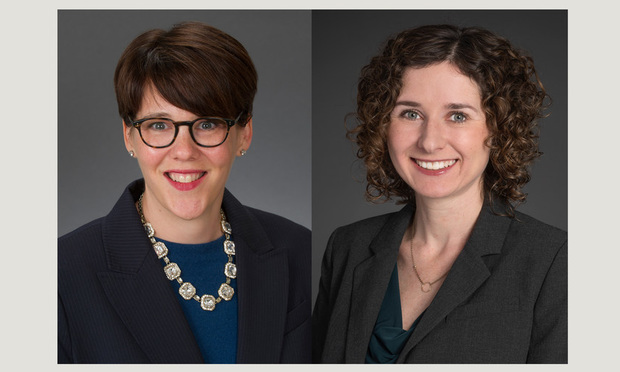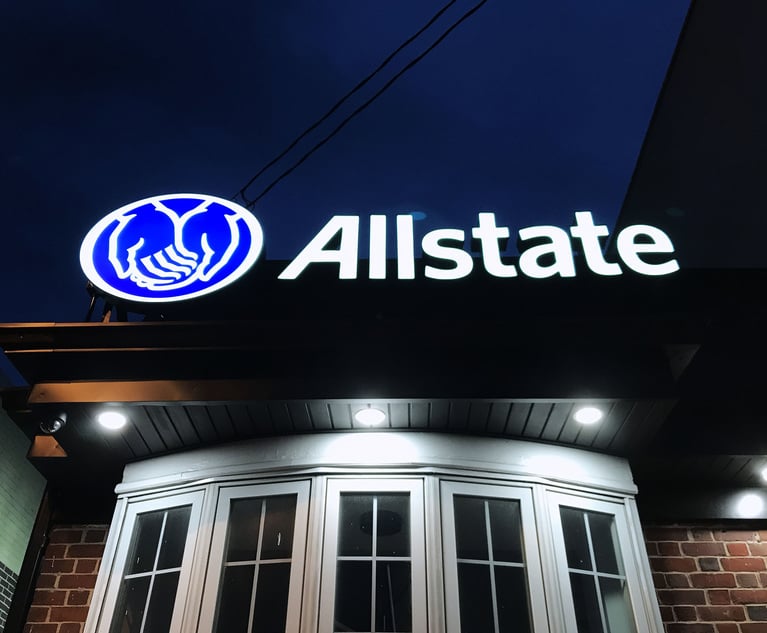AB 5: Changing the Landscape for Independent Contractor Analysis
Although the national media has largely focused on the effects on ride-hailing, meal delivery and other gig economy workers, the effects of AB 5 are much broader and are worrying those in many industries including technology, media, transportation and entertainment.
September 19, 2019 at 04:10 PM
6 minute read
 Katherine A. Roberts (left) and Galit A. Knotz (right) of Sidley Austin.
Katherine A. Roberts (left) and Galit A. Knotz (right) of Sidley Austin.
On Sept. 19, Gov. Gavin Newsom signed into law Assembly Bill 5 (AB 5), a sweeping new law that makes it significantly more difficult for most workers in the state to qualify as independent contractors. With the governor's approval, the California Legislature has once again enacted a law that imposes significant changes on companies without providing much of a roadmap for compliance. The law takes effect on Jan. 1, 2020.
Although the national media has largely focused on the effects on ride-hailing, meal delivery and other gig economy workers, the effects of AB 5 are much broader and are worrying those in many industries including technology, media, transportation and entertainment.
What AB 5 Does
AB 5 codifies the Dynamex Operations West v. Superior Court of Los Angeles (Dynamex) case, decided by the California Supreme Court in April 2018. In that case, the court abandoned the 20-year-old test for independent contractors set forth in Borello & Sons v. Department of Industrial Relations (Borello). The Borello test considered many factors related to the amount of control an employer exerted over a purported independent contractor, none of which was determinative on its own.
In, Dynamex, the court embraced a standard that presumes workers are employees rather than independent contractors, unless the hiring entity can show that the workers meet all three prongs of the so-called "ABC test," and thus can qualify for independent contractor status. The "ABC" requirements are that:
(A) The hiring entity does not control or direct the performance of work;
(B) The person performs work outside the usual course of the hiring entity's business; and
(C) The person is customarily engaged in an independently established trade, occupation or business.
If the hiring entity cannot meet the ABC test, the worker is considered an employee and thus may be eligible for a slew of rights and benefits previously unavailable to them, including minimum wage, overtime pay, and meal and rest breaks, among other protections under the Labor Code; employee benefits such as health benefits, stock options and 401k; coverage under the employer's workers' compensation, unemployment and disability insurance; and eligibility for paid sick days and paid family leave.
Who Is Exempt From AB 5 and What Does That Mean?
AB 5 contains exemptions for a wide variety of professions, including certain health and other licensed professionals, broker-dealers, direct salespeople and commercial fishermen.
It is important to note, however, that exempt occupations are not automatically "safe" in their independent contractor status. Rather, workers in exempt occupations get the benefit of using the more lenient Borello standard instead of the Dynamex ABC test.
AB 5 also includes a list of additional exemptions that have their own factors which must be established in order for the ABC test not to apply (presumably in addition to meeting the test under Borello). By way of example, AB 5 exempts workers in enumerated "professional services," if the hiring entity can demonstrate that it meets all of the following factors:
- The individual maintains a business location separate from the hiring entity;
- The individual has a business license, in addition to any required professional licenses or permits for the individual to practice in their profession (provided such work occurs six months after Jan. 1, 2020);
- The individual has the ability to set or negotiate their own rates for the services performed;
- Outside of project completion dates and reasonable business hours, the individual has the ability to set the individual's own hours;
- The individual is customarily engaged in the same type of work performed under contract with another hiring entity or holds themselves out to other potential customers as available to perform the same type of work; and
- The individual customarily and regularly exercises discretion and independent judgment in the performance of the services.
The "professional services" exemption includes a host of jobs and industries—which themselves are subject to exceptions—including, in broad terms, marketer, human resource administrator, graphic designer, grant writer, fine artist, photojournalist, freelance writer, editor or newspaper cartoonist, licensed esthetician, licensed electrologist, licensed manicurist, licensed barber and licensed cosmetologist. As noted above, there are additional exemptions subject to their own list of factors, including for businesses that are formed as a sole proprietorship, partnership, limited liability company, limited liability partnership, or corporation; some construction industry occupations; and "the relationship between a referral agency and a service provider" (where a "referral agency" is a business that connects clients with service providers that provide graphic design, photography, tutoring, event planning, minor home repair, moving, home cleaning, errands, furniture assembly, animal services, dog walking, dog grooming, web design, picture hanging, pool cleaning or yard cleanup).
Notably absent from all the enumerated exemptions are workers from the entertainment, ridesharing/delivery and trucking industries, among others.
Further, AB 5 allows courts to apply the more flexible Borello test "based on grounds other than an express exception to employment status." That test is centered on the hiring entity's control over the work at issue, including the manner in which is performed. But the bill provides no guidance on when such application would be appropriate, and thus potentially opens the door for litigation in the face of what may otherwise appear to be a law that aims to provide clarity.
Without question, AB 5 changes the landscape for companies that utilize independent contractors in California. But it also opens the door to misinterpretation, uncertainty and further litigation. Thus, the quick takeaways for employers are as follows:
- No position or industry in California is statutorily authorized to use independent contractors—thus every hiring entity must continue to review its classification. The only question is, which test applies?
- Even though AB 5 has now been signed into law, there is reason to believe that the law is still in flux. For example, the state legislature passed Assembly Bill 170 (AB 170) on Sept. 14, giving newspaper publishers until Jan. 1, 2021, to reclassify their delivery drivers from contractors to employees. Many believe this recent bill, which is considered a companion piece to AB 5, demonstrates that the full reach of AB 5 has not been finalized just yet, as many industries continue to push for more exemptions through more companion bills or emergency legislation.
- AB 5 is not likely to provide the clarity it purports to bring: several of the exemptions are unclear; the judicial mandate for circumventing the application of Dynamex will undoubtedly generate litigation; and several industries have openly vowed to challenge the bill through ballot initiatives.
Galit A. Knotz is counsel and Katherine A. Roberts is a partner in Sidley Austin's Los Angeles office. They are labor and employment litigators and counselors whose practices focus on class and representative actions including PAGA, wage-and-hour issues, discrimination and traditional labor matters arising under the National Labor Relations Act.
This content has been archived. It is available through our partners, LexisNexis® and Bloomberg Law.
To view this content, please continue to their sites.
Not a Lexis Subscriber?
Subscribe Now
Not a Bloomberg Law Subscriber?
Subscribe Now
NOT FOR REPRINT
© 2025 ALM Global, LLC, All Rights Reserved. Request academic re-use from www.copyright.com. All other uses, submit a request to [email protected]. For more information visit Asset & Logo Licensing.
You Might Like
View All
Hawaii wildfire victims spared from testifying after last-minute deal over $4B settlement
4 minute read
State Appeals Court Revives BraunHagey Lawsuit Alleging $4.2M Unlawful Wire to China
3 minute read

Apple Disputes 'Efforts to Manufacture' Imaging Sensor Claims Against iPhone 15 Technology
Trending Stories
- 1Two Wilkinson Stekloff Associates Among Victims of DC Plane Crash
- 2Two More Victims Alleged in New Sean Combs Sex Trafficking Indictment
- 3Jackson Lewis Leaders Discuss Firm's Innovation Efforts, From Prompt-a-Thons to Gen AI Pilots
- 4Trump's DOJ Files Lawsuit Seeking to Block $14B Tech Merger
- 5'No Retributive Actions,' Kash Patel Pledges if Confirmed to FBI
Who Got The Work
J. Brugh Lower of Gibbons has entered an appearance for industrial equipment supplier Devco Corporation in a pending trademark infringement lawsuit. The suit, accusing the defendant of selling knock-off Graco products, was filed Dec. 18 in New Jersey District Court by Rivkin Radler on behalf of Graco Inc. and Graco Minnesota. The case, assigned to U.S. District Judge Zahid N. Quraishi, is 3:24-cv-11294, Graco Inc. et al v. Devco Corporation.
Who Got The Work
Rebecca Maller-Stein and Kent A. Yalowitz of Arnold & Porter Kaye Scholer have entered their appearances for Hanaco Venture Capital and its executives, Lior Prosor and David Frankel, in a pending securities lawsuit. The action, filed on Dec. 24 in New York Southern District Court by Zell, Aron & Co. on behalf of Goldeneye Advisors, accuses the defendants of negligently and fraudulently managing the plaintiff's $1 million investment. The case, assigned to U.S. District Judge Vernon S. Broderick, is 1:24-cv-09918, Goldeneye Advisors, LLC v. Hanaco Venture Capital, Ltd. et al.
Who Got The Work
Attorneys from A&O Shearman has stepped in as defense counsel for Toronto-Dominion Bank and other defendants in a pending securities class action. The suit, filed Dec. 11 in New York Southern District Court by Bleichmar Fonti & Auld, accuses the defendants of concealing the bank's 'pervasive' deficiencies in regards to its compliance with the Bank Secrecy Act and the quality of its anti-money laundering controls. The case, assigned to U.S. District Judge Arun Subramanian, is 1:24-cv-09445, Gonzalez v. The Toronto-Dominion Bank et al.
Who Got The Work
Crown Castle International, a Pennsylvania company providing shared communications infrastructure, has turned to Luke D. Wolf of Gordon Rees Scully Mansukhani to fend off a pending breach-of-contract lawsuit. The court action, filed Nov. 25 in Michigan Eastern District Court by Hooper Hathaway PC on behalf of The Town Residences LLC, accuses Crown Castle of failing to transfer approximately $30,000 in utility payments from T-Mobile in breach of a roof-top lease and assignment agreement. The case, assigned to U.S. District Judge Susan K. Declercq, is 2:24-cv-13131, The Town Residences LLC v. T-Mobile US, Inc. et al.
Who Got The Work
Wilfred P. Coronato and Daniel M. Schwartz of McCarter & English have stepped in as defense counsel to Electrolux Home Products Inc. in a pending product liability lawsuit. The court action, filed Nov. 26 in New York Eastern District Court by Poulos Lopiccolo PC and Nagel Rice LLP on behalf of David Stern, alleges that the defendant's refrigerators’ drawers and shelving repeatedly break and fall apart within months after purchase. The case, assigned to U.S. District Judge Joan M. Azrack, is 2:24-cv-08204, Stern v. Electrolux Home Products, Inc.
Featured Firms
Law Offices of Gary Martin Hays & Associates, P.C.
(470) 294-1674
Law Offices of Mark E. Salomone
(857) 444-6468
Smith & Hassler
(713) 739-1250






